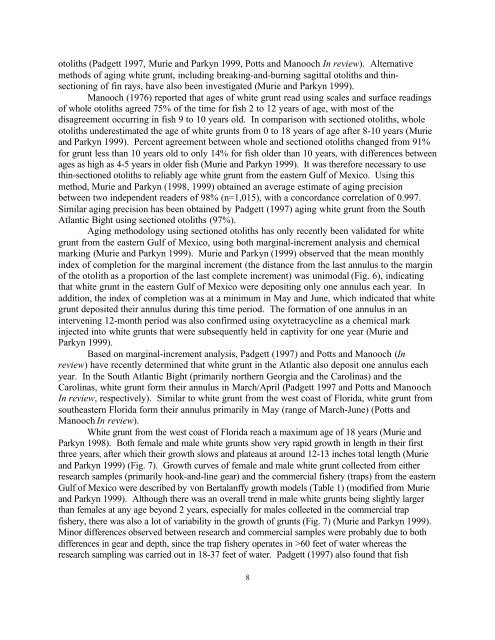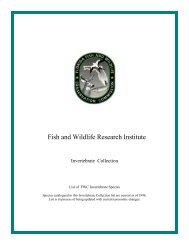STOCK ASSESSMENT OF WHITE GRUNT FROM THE WEST ...
STOCK ASSESSMENT OF WHITE GRUNT FROM THE WEST ...
STOCK ASSESSMENT OF WHITE GRUNT FROM THE WEST ...
Create successful ePaper yourself
Turn your PDF publications into a flip-book with our unique Google optimized e-Paper software.
otoliths (Padgett 1997, Murie and Parkyn 1999, Potts and Manooch In review). Alternative<br />
methods of aging white grunt, including breaking-and-burning sagittal otoliths and thinsectioning<br />
of fin rays, have also been investigated (Murie and Parkyn 1999).<br />
Manooch (1976) reported that ages of white grunt read using scales and surface readings<br />
of whole otoliths agreed 75% of the time for fish 2 to 12 years of age, with most of the<br />
disagreement occurring in fish 9 to 10 years old. In comparison with sectioned otoliths, whole<br />
otoliths underestimated the age of white grunts from 0 to 18 years of age after 8-10 years (Murie<br />
and Parkyn 1999). Percent agreement between whole and sectioned otoliths changed from 91%<br />
for grunt less than 10 years old to only 14% for fish older than 10 years, with differences between<br />
ages as high as 4-5 years in older fish (Murie and Parkyn 1999). It was therefore necessary to use<br />
thin-sectioned otoliths to reliably age white grunt from the eastern Gulf of Mexico. Using this<br />
method, Murie and Parkyn (1998, 1999) obtained an average estimate of aging precision<br />
between two independent readers of 98% (n=1,015), with a concordance correlation of 0.997.<br />
Similar aging precision has been obtained by Padgett (1997) aging white grunt from the South<br />
Atlantic Bight using sectioned otoliths (97%).<br />
Aging methodology using sectioned otoliths has only recently been validated for white<br />
grunt from the eastern Gulf of Mexico, using both marginal-increment analysis and chemical<br />
marking (Murie and Parkyn 1999). Murie and Parkyn (1999) observed that the mean monthly<br />
index of completion for the marginal increment (the distance from the last annulus to the margin<br />
of the otolith as a proportion of the last complete increment) was unimodal (Fig. 6), indicating<br />
that white grunt in the eastern Gulf of Mexico were depositing only one annulus each year. In<br />
addition, the index of completion was at a minimum in May and June, which indicated that white<br />
grunt deposited their annulus during this time period. The formation of one annulus in an<br />
intervening 12-month period was also confirmed using oxytetracycline as a chemical mark<br />
injected into white grunts that were subsequently held in captivity for one year (Murie and<br />
Parkyn 1999).<br />
Based on marginal-increment analysis, Padgett (1997) and Potts and Manooch (In<br />
review) have recently determined that white grunt in the Atlantic also deposit one annulus each<br />
year. In the South Atlantic Bight (primarily northern Georgia and the Carolinas) and the<br />
Carolinas, white grunt form their annulus in March/April (Padgett 1997 and Potts and Manooch<br />
In review, respectively). Similar to white grunt from the west coast of Florida, white grunt from<br />
southeastern Florida form their annulus primarily in May (range of March-June) (Potts and<br />
Manooch In review).<br />
White grunt from the west coast of Florida reach a maximum age of 18 years (Murie and<br />
Parkyn 1998). Both female and male white grunts show very rapid growth in length in their first<br />
three years, after which their growth slows and plateaus at around 12-13 inches total length (Murie<br />
and Parkyn 1999) (Fig. 7). Growth curves of female and male white grunt collected from either<br />
research samples (primarily hook-and-line gear) and the commercial fishery (traps) from the eastern<br />
Gulf of Mexico were described by von Bertalanffy growth models (Table 1) (modified from Murie<br />
and Parkyn 1999). Although there was an overall trend in male white grunts being slightly larger<br />
than females at any age beyond 2 years, especially for males collected in the commercial trap<br />
fishery, there was also a lot of variability in the growth of grunts (Fig. 7) (Murie and Parkyn 1999).<br />
Minor differences observed between research and commercial samples were probably due to both<br />
differences in gear and depth, since the trap fishery operates in >60 feet of water whereas the<br />
research sampling was carried out in 18-37 feet of water. Padgett (1997) also found that fish<br />
8




